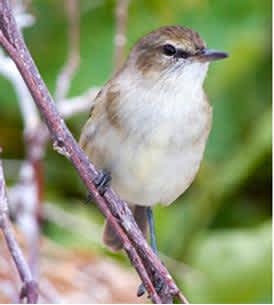100 Years Later, Endangered Millerbirds Breed Once Again on Laysan Island
OutdoorHub 03.16.12

Endangered Millerbirds, recently reintroduced to Hawai‘i’s Laysan Island after a 100-year absence, are now breeding there, a major step forward in efforts to save the species from extinction.
In September of 2011, 24 of the tiny songbirds were relocated from their last remaining holdout on remote Nihoa Island to Laysan Island. In a bold effort, birds were transported 650 miles northwest by sea to initiate a second population and minimize the risk of extinction. Biologists monitoring the birds have just reported that some of the birds have laid eggs, and some of these eggs have now hatched—an encouraging sign that the birds will thrive in their new home.
Shortly after they arrived last fall, the Millerbirds made an unsuccessful out-of-season breeding attempt. Now the birds are entering their first proper breeding season with promising early results. Nest building activity was first observed on Valentine’s Day. The first complete nest of the season was discovered the last week of February, and the first eggs on March 8. Since then, birds from a total of eight pairs have been seen carrying nest material, building nests, or exhibiting other breeding behavior. As of March 15, two pairs are incubating eggs, and one pair is feeding nestlings. The project team now waits with bated breath for the first Millerbird chicks to fledge. This first-ever opportunity to observe Millerbird breeding from start to finish and collect behavioral and life-history data throughout the season is a significant advance in the study of this endangered species.
The first Millerbird translocation to Laysan Island, which is within Hawaiian Islands National Wildlife Refuge and the Papahānaumokuākea Marine National Monument, was the result of many years of research and detailed planning by biologists and resource managers, led by a partnership between the U.S. Fish and Wildlife Service (FWS) and American Bird Conservancy (ABC).
“The Millerbird translocation has been a success so far. The birds’ rapid acclimation to their new home surpassed our expectations,” said Loyal Mehrhoff, Field Supervisor for the Pacific Islands Fish and Wildlife Office. “They showed us they had no trouble finding each other in the relative vastness of Laysan, forming pair-bonds, building nests, and incubating eggs.”
“This is a great example of collaborative conservation between the U.S. Fish and Wildlife Service and ABC, and a demonstration of the kind of concrete action needed to conserve Hawai‘i’s remaining endangered species,” said George Wallace, ABC’s Vice President for Oceans and Islands. “By creating a second population of Millerbirds on a second, distant island, the translocation project will reduce the chances that catastrophic events on Nihoa, such as hurricanes or the introduction of predators, will drive the Millerbird to extinction. Plans are already underway for a second translocation to ensure that the Laysan population has a solid foundation to build upon.”
Post-release monitoring indicates that at least 21 of the birds have survived the winter storm season on Laysan. Three of the birds have not been seen for several months, but other “missing” birds have made dramatic reappearances after absences as long as 112 days, so it may be premature to assume that any of the birds have been lost. If they are not singing, Millerbirds can be mouse-like and stay hidden in dense vegetation, making them hard to find.
Following overwinter survival, the next important milestone for Millerbirds on Laysan will be when chicks fledge (leave the nest) and forage on their own. Following that, the project team will be looking for this first generation of Laysan-hatched birds to begin breeding themselves.
Biologists have been stationed on Laysan Island for the first six months of post-release monitoring (see project updates here and here). These two biologists will soon be replaced by a third biologist, who will monitor the birds through the spring and summer.
Prior to the translocation, Millerbirds only occurred on the 155-acre island of Nihoa, where their population is currently estimated at 775 birds. Millerbirds historically occurred on Laysan but were extirpated sometime prior to 1923, a result of the devastation of the island’s vegetation by rabbits and other introduced grazing mammals.
At over 1,025 acres, Laysan is much larger than Nihoa. Although the Millerbirds have mostly remained in the area surrounding the release site in the northern portion of the island, two birds have made treks to the far southern end of the island, nearly a mile away. One bird has made the round trip several times!
The Millerbird, which weighs less than an ounce, is a lively, brown songbird that forages for insects among low shrubs and bunch-grasses. On Laysan, the Millerbird joins other endangered species, such as the Laysan Finch, Laysan Duck, Hawaiian monk seal, and several plant species, as well as millions of nesting seabirds.
Papahānaumokuākea Marine National Monument is co-managed by FWS, the National Oceanic and Atmospheric Administration, and the State of Hawai‘i. ABC and FWS are grateful for the support of the National Fish and Wildlife Foundation through their Hawai‘i Forest Bird Keystone Initiative, the University of New Brunswick, University of Hawai‘i, Pacific Rim Conservation, the USGS National Wildlife Health Research Center, the Office of Hawaiian Affairs, and the Papahānaumokuākea Marine National Monument.

